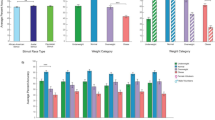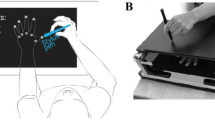Abstract
OBJECTIVE: To establish body mass index (BMI) norms for standard figural stimuli using a large Caucasian population-based sample. In addition, we sought to determine the effectiveness of the figural stimuli to identify individuals as obese or thin.
DESIGN: All Caucasian twins born in Virginia between 1915 and 1971 were identified by public birth record. In addition, 3347 individual twins responded to a letter published in the newsletter of the American Association of Retired Persons (AARP). All adult twins (aged 18 and over) from both of these sources and their family members were mailed a 16 page ‘Health and Lifestyle’ questionnaire.
SUBJECTS: BMI and silhouette data were available on 16 728 females and 11 366 males ranging in age from 18–100.
MEASUREMENTS: Self-report information on height-weight, current body size, desired body size and a discrepancy score using standard figural stimuli.
RESULTS: Gender- and age-specific norms are presented linking BMI to each of the figural stimuli. Additional norms for desired body size and discrepancy scores are also presented. Receiver operating curves (ROC) indicate that the figural stimuli are effective in classifying individuals as obese or thin.
CONCLUSIONS: With the establishment of these norms, the silhouettes used in standard body image assessment can now be linked to BMI. Differences were observed between women and men in terms of desired body size and discrepancy scores, with women preferring smaller sizes. The figural stimuli are a robust technique for classifying individuals as obese or thin.
This is a preview of subscription content, access via your institution
Access options
Subscribe to this journal
Receive 12 print issues and online access
$259.00 per year
only $21.58 per issue
Buy this article
- Purchase on Springer Link
- Instant access to full article PDF
Prices may be subject to local taxes which are calculated during checkout




Similar content being viewed by others
References
Stunkard A, Sørensen T, Schulsinger F . Use of the Danish Adoption Register for the study of obesity and thinness. In: Kety S, Roland L, Sidman R, Matthysse S (eds). The genetics of neurological and psychiatric disorders Raven Press: New York 1983
Fallon AE, Rozin P . Sex differences in perceptions of desirable body shape J Abnorm Psychol 1985 94: 102–105.
Sørensen T, Stunkard A, Teasdale T, Higgins M . The accuracy of reports of weight: children's recall of their parents' weights 15 y earlier Int J Obes 1983 7: 115–122.
Sørensen T, Stunkard AJ . Does obesity run in families because of genes? An adoption study using silhouettes as a measure of obesity. Acta Psych Scand 1993 370: (Suppl): 67–72.
Stunkard A, Sørensen T, Hanis C, Teasdale T, Chakraborty R, Schull W et al. An adoption study of human obesity New Engl J Med 1986 314: 193–198.
Gardner RM, Friedman BN, Jackson NA . Methodological concerns when using silhouettes to measure body image Percept Motor Skills 1998 86: 387–395.
Stunkard A . Old and new scales for the assessment of body image Percept Motor Skills 2000 90: (3 Pt 1): 930.
Truett K, Eaves L, Walters E, Heath A, Hewitt J, Meyer J et al. A model system for analysis of family resemblance in extended kinships of twins Behav Genet 1994 24: 35–49.
SAS Institute Inc . SAS/STAT=AE software Changes and enhancements through Release 6.11 SAS Institute, Inc.: Cary, NC 1996
Moosman D, Somoza E . ROC curves, test accuracy, and the description of diagnostic tests J Neuropsychiat 1991 3: 330–333.
Brownell K . Dieting and the search for the perfect body: where physiology and culture collide Behav Ther 1991 22: 1–12.
Norgan NG . Population differences in body composition in relation to the body mass index Eur J Clin Nutr 1994 48: (Suppl 3) S10–25 (discussion S26 – 27).
Lynch J, Wang XL, Wilcken DE . Body mass index in Australian children: recent changes and relevance of ethnicity Arch Dis Child 2000 82: 16–20.
Katzmarzyk PT, Mahaney MC, Blangero J, Quek JJ, Malina RM . Potential effects of ethnicity in genetic and environmental sources of variability in the stature, mass and body mass index of children Hum Biol 1999 71: 977–987.
Altabe M . Ethnicity and body image: quantitative and qualitative analysis Int J Eat Disord 1998 23: 153–159.
Miller KJ, Gleaves DH, Hirsch TG, Green BA, Snow AC, Corbett CC . Comparisons of body image dimensions by race/ethnicity and gender in a university population Int J Eat Disord 2000 27: 310–316.
Stunkard A, Waxman M . The accuracy of self-reports of food intake: a review of the literature and a report of a very small series J Am Diet Assoc 1981 79: 547–551.
Pirie P, Jacobs D, Jeffery R, Hannan P . Distortion in self-reported height and weight data J Am Diet Assoc 1981 78: 601–606.
Cunningham F, MacDonald P, Gant N . Multifetal pregnancy Appleton and Lange: Norwalk, CT 1989
Kendler KS . Twin studies of psychiatric illness Arch Gen Psychiat 1993 50: 905–915.
Pietilainen KH, Kaprio J, Rissanen A, Winter T, Rimpela A, Viken RJ et al. Distribution and heritability of BMI in Finnish adolescents aged 16 y and 17 y: a study of 4884 twins and 2509 singletons Int J Obes Relat Metab Disord 1999 23: 107–115.
Acknowledgements
This work was supported by grants: GM-30250; AG-04954; AA-06781; MH-40828, HL-48148; and K01-MH01553
Author information
Authors and Affiliations
Corresponding author
Rights and permissions
About this article
Cite this article
Bulik, C., Wade, T., Heath, A. et al. Relating body mass index to figural stimuli: population-based normative data for Caucasians. Int J Obes 25, 1517–1524 (2001). https://doi.org/10.1038/sj.ijo.0801742
Received:
Revised:
Accepted:
Published:
Issue Date:
DOI: https://doi.org/10.1038/sj.ijo.0801742
Keywords
This article is cited by
-
The association between general and central obesity and the risks of coronary heart disease in women with and without a familial predisposition to obesity: findings from the Danish Nurse Cohort
International Journal of Obesity (2022)
-
Women’s Reasons to Seek Bariatric Surgery and Their Expectations on the Surgery Outcome — a Multicenter Study from Five European Countries
Obesity Surgery (2022)
-
Leading When Overweight: the Influence of Supervisor Body Weight on Subordinates’ Perceptions and Citizenship Behaviors
Journal of Business and Psychology (2022)
-
Parents’ perceptions and dissatisfaction with child silhouette: associated factors among 7-year-old children of the Generation XXI birth cohort
Eating and Weight Disorders - Studies on Anorexia, Bulimia and Obesity (2021)
-
Development and validation of new figural scales for female body dissatisfaction assessment on two dimensions: thin-ideal and muscularity-ideal
BMC Public Health (2020)



